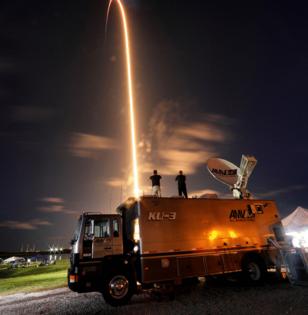More rocket launches could light up the San Diego sky as SpaceX builds out satellite network
Published in Science & Technology News
The spectacular sight of a SpaceX Falcon 9 rocket streaking across the San Diego County sky may become much more familiar in the months ahead.
The U.S. Space Force and SpaceX have asked the California Coastal Commission to approve an increase to as many as 36 launches a year at Vandenberg Space Force Base on the state's Central Coast.
The Vandenberg launches have averaged six annually for the past five years, although the number steadily increased to a total of 28 in 2023.
SpaceX has been ramping up launches as it builds out a network of nearly 42,000 Starlink satellites to provide worldwide internet service. As of March, it had launched more than 5,500 satellites. The company has a roster of other launch customers, including NASA and the Pentagon.
The West Coast space base is one of four launch sites for Space X. The others are at Cape Canaveral and the Kennedy Space Center, both in Florida, and another in Brownsville, Texas.
Usually taking off near sunset, the rockets leave a long, undulating trail in the sky that draws widespread attention. Photos appear in the news and social media posts, although that could happen less frequently as the phenomenon becomes more common.
The Coastal Commission is expected to approve the expansion at a meeting Wednesday in Long Beach.
That will be good for the entire region, said Henrik Christensen, a professor in the Department of Computer Science and Engineering at the University of California San Diego, and the director of its Contextual Robotics Institute.
"The space industry benefits tremendously from seeing more activity in Southern California," Christensen said. "There are multiple companies that do consulting engineering for space."
UCSD students have designed and built rocket engines and satellites, he said. Some have gone on to work for NASA, or for the private companies SpaceX, founded by Elon Musk, and Blue Origin, founded by Jeff Bezos.
Rocket-building skills also transfer over into other areas such as underwater exploration and defense industries, Christensen said.
The launches may even boost local tourism, he said. People will drive many miles to see the launches, and they can see them anywhere along the Southern California coast.
"It's another thing to see in San Diego," he said.
The proposed SpaceX expansion at Vandenberg includes the additional landings of the rocket's reusable first stage. The second stage, which is not reusable, delivers the payload into orbit and then eventually falls back to earth and burns up in the atmosphere.
Some of the landings would be on a drone ship somewhere in the ocean at least 31 miles from the coast and as far out as several hundred miles, anywhere between the latitudes of Los Angeles and the middle of Baja California. Some of the first stages also land on a platform at Vandenberg.
SpaceX moved one of its drone ships, essentially a modified barge, from Port Canaveral in Florida to the Port of Long Beach in California in 2021. The platform is towed to and from a location near the landing, but once there it can remotely adjust its position.
Named the "Of Course I Still Love You," the drone ship was used as recently as January for a successful landing off the coast of Baja California. The trip to earth orbit is quick, and, in that case, the landing occurred just 8.5 minutes after the takeoff.
Coastal Commission staffers determined the expansion qualifies for a "negative declaration," which means they expect no significant environmental impacts from the launches.
"The project has the potential to result in a variety of effects on California coastal resources, including the release of debris into the ocean and disturbance to sensitive species due to elevated sound levels," the commission's report states.
"The proposed launches would serve the primary purpose of placing into Earth orbit thousands of small satellites for SpaceX's 'Starlink' commercial satellite internet business," the report states. Each rocket can carry as many as 22 satellites.
Air quality may be the first concern in the mind of anyone who has seen the rocket's long trail of vapor across the evening sky, yet the reported emissions are below applicable state and federal standards.
"The exhaust from Falcon 9 rocket launches is fuel-rich and contains high concentrations of carbon monoxide (CO)," states the commission's report. "Subsequent entrainment of ambient air results in complete conversion of CO into carbon dioxide (CO2) and oxidation of the soot from the exhaust."
The liquid rocket fuel consists rocket-grade kerosene combined with liquid oxygen. When it burns it produces "a diminutive amount of soot" and a small amount of nitrogen oxide (NO) in the exhaust. As a result, the emissions conform to the standards of the federal Clean Air Act.
Weather balloons related to the launches are a significant source of marine debris, the report states.
"Up to 36 weather balloons would be released prior to each launch to measure upper atmosphere conditions and would then fall to the ocean below in state or federal waters," it states. "Due to the height it would fall from and large ocean area in may land in ... it would not be feasible to recover each weather balloon and associated instrument array."
The payload includes a fairing or shield that is released in space and falls to earth, slowed by a parachute, but that cannot be recovered. Also, in some cases the first stage of the rocket may fall into the ocean and not be recovered.
As a result, SpaceX is required to make a monetary donation of $10 for each pound of ocean debris to the University of California Davis' California Lost Fishing Gear Recovery Project.
The launches also expose wildlife to "elevated sound levels," although so far no adverse effects have been determined.
_____
©2024 The San Diego Union-Tribune. Visit sandiegouniontribune.com. Distributed by Tribune Content Agency, LLC.







Comments